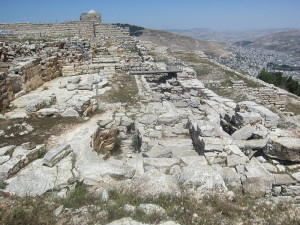Procopius of Caesarea, Buildings V, vii: The First Samaritan Rebellion
 This description of the first Samaritan rebellion by Procopius of Caesarea, a Byzantine historian, was written between 559 and 560 C.E. This account highlights the religious nature of the struggle, supporting the notion that Christian persecution of the Samaritans led to the unleashing of the revolt.
This description of the first Samaritan rebellion by Procopius of Caesarea, a Byzantine historian, was written between 559 and 560 C.E. This account highlights the religious nature of the struggle, supporting the notion that Christian persecution of the Samaritans led to the unleashing of the revolt.
In Palestine there is a city named Neapolis (98), above which rises a high mountain, called Garizin. This mountain the Samaritans originally held; and they had been wont to go up to the summit of the mountain to pray on all occasions, not because they had ever built any temple there, but because they worshipped the summit itself with the greatest reverence….
During the reign of Zeno, the Samaritans suddenly banded together and fell upon the Christians in Neapolis in the church while they were celebrating the festival called Pentecost (99), and they destroyed many of them. They struck with their swords the man who at that time was their Bishop, Terebinthius by name, finding him standing at the holy table as he performed the mysteries. They slashed at him and cut off the fingers of his hand, and they railed at the mysteries, as is natural for Samaritans to do, while we honor them with silence. And this priest straightaway came to Byzantium and appeared before the ruling emperor and displayed what he had suffered, setting forth what had happened and reminding the emperor of the prophecy of Christ (100), and he begged him to avenge all that had been done.
The Emperor Zeno was greatly disturbed by what had happened, and with no delay inflicted punishment in due measure upon those who had done the terrible thing. He drove out the Samaritans from Mt. Garizin and straightaway handed it over to the Christians, and building a church on the summit, he dedicated it to the Mother of God, putting a barrier, as it was made to appear, around this church, though in reality he erected only a light wall of stone. And he established a garrison of soldiers, placing a large number in the city below, but not more than ten men at the fortifications and the church. The Samaritans resented this, and chafed bitterly in their vexation and deplored their condition, but through fear of the emperor they bore their distress in silence.
But at a later time, when Anastasius was holding the imperial office (101), the following happened. Some of the Samaritans, incited by a woman’s suggestion, unexpectedly climbed the steep face of the mountain, since the path which leads up from the city was carefully guarded, and it was impossible for them to attempt the ascent by that route. Entering the church suddenly, they slew the guards there and with a mighty cry summoned the Samaritans in the city. They, however, through fear of the soldiers, were by no means willing to join the attempt of the conspirators. And not long afterwards the governor of the district (he was Procopius of Edessa, a man of learning) arrested the authors of the outrage and put them to death. Yet even after that no thought was taken for the fortifications, and no provision for proper defense was made at that time by the emperor. But during the present reign, although the emperor Justinian has converted the Samaritans for the most part to a more pious way of life and has made them Christians, he left the old fortification around the church on Garizin in the form in which it was, that is merely a barrier, as I have said. But by surrounding this with another wall on the outside he made the place absolutely impregnable. There too he restored five shrines of the Christians which had been burned down by the Samaritans.
Trans. H. B. Dewing, Procopius, with an English Translation, The Anecdota or Secret History (Loeb Classical Library; Cambridge Harvard University Press, 1971), vol. 7, pp. 349-55.
98. Modern Nablus.
99. A Christian festival celebrated fifty days after Easter Sunday.
100. That the Samaritans would no longer worship on Mt. Gerizim but that the Christians would worship there (John 4-21-4).
101. 491-518 C.E.



